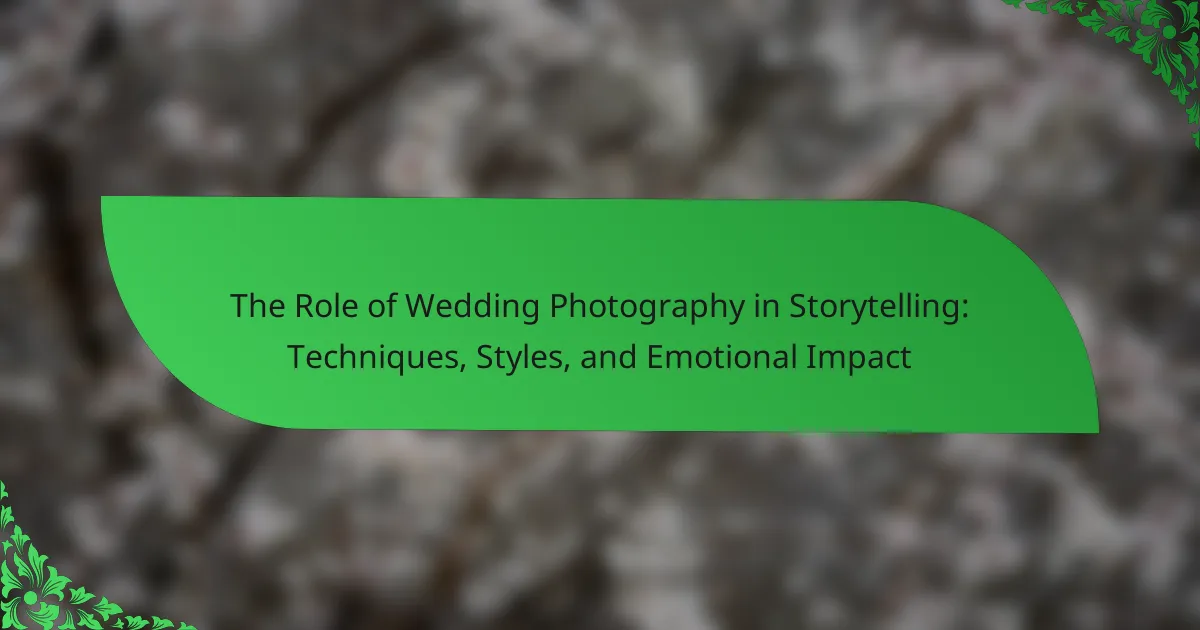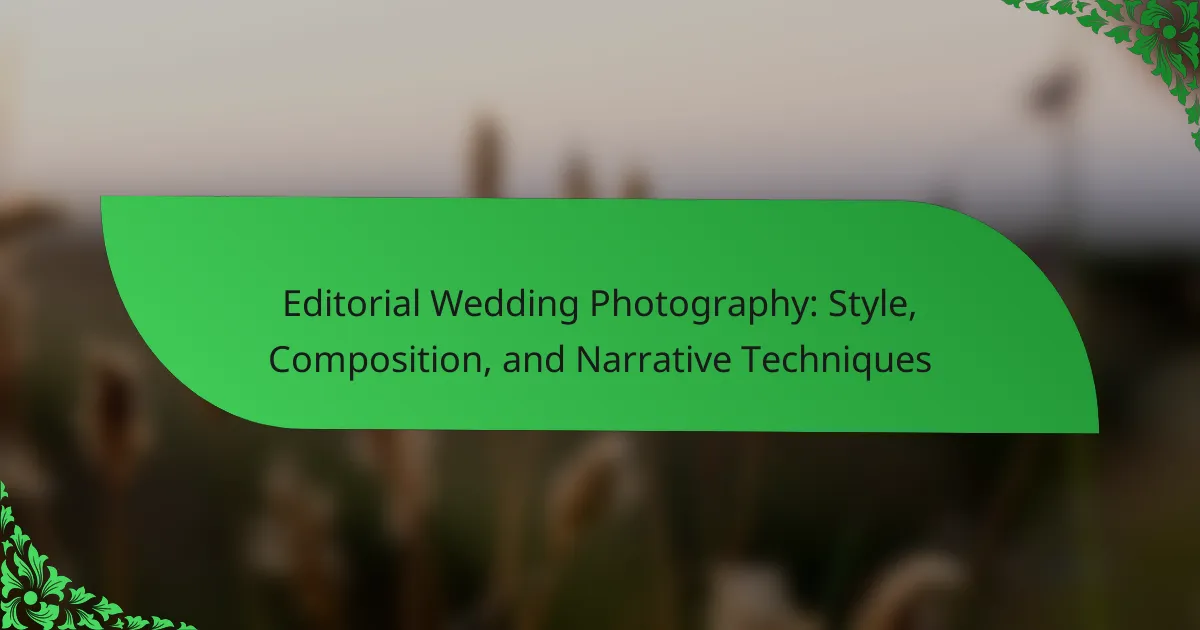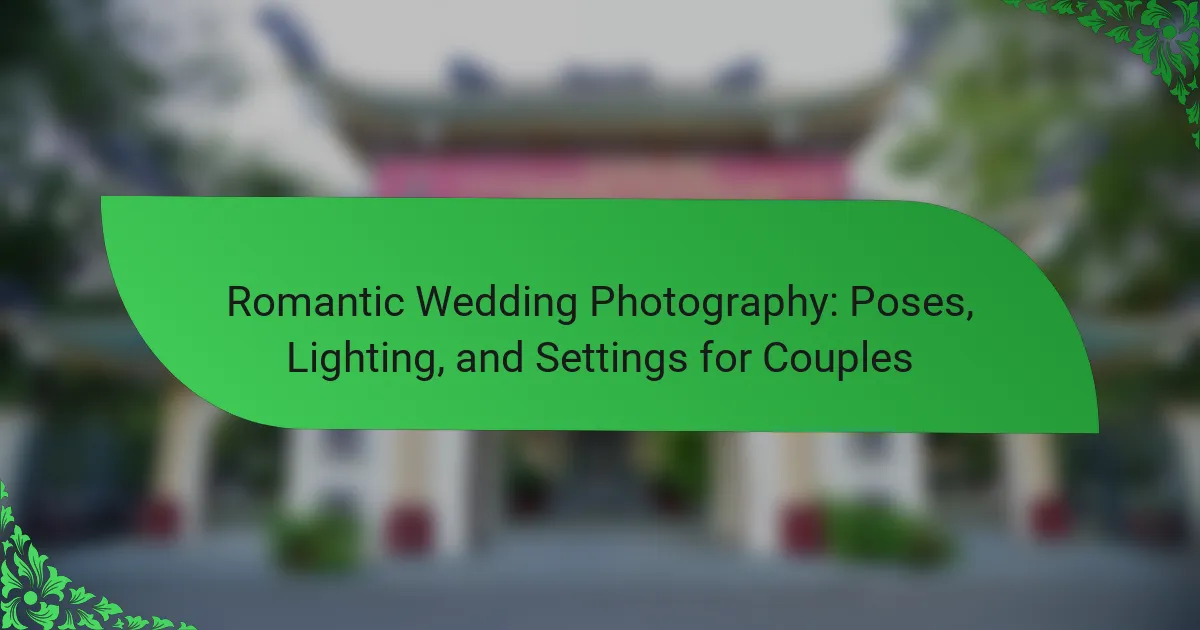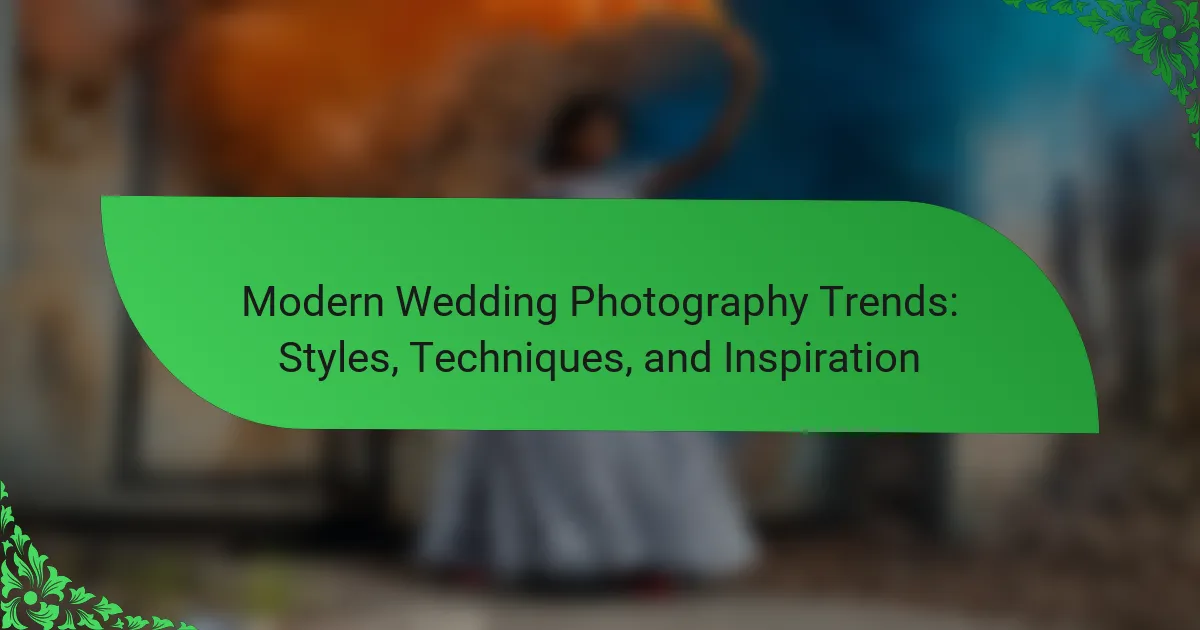Wedding photography serves as a vital tool for visual storytelling, capturing key moments, emotions, and details of a couple’s special day. This article explores various techniques, including candid photography, posed portraits, detail shots, documentary styles, fine art, traditional, and editorial photography, each contributing uniquely to the narrative of the wedding. By documenting genuine interactions and significant elements, wedding photography enhances the emotional impact of the experience and preserves lasting memories. The combination of these styles creates a comprehensive narrative that reflects the couple’s journey, celebrating their love and connections.
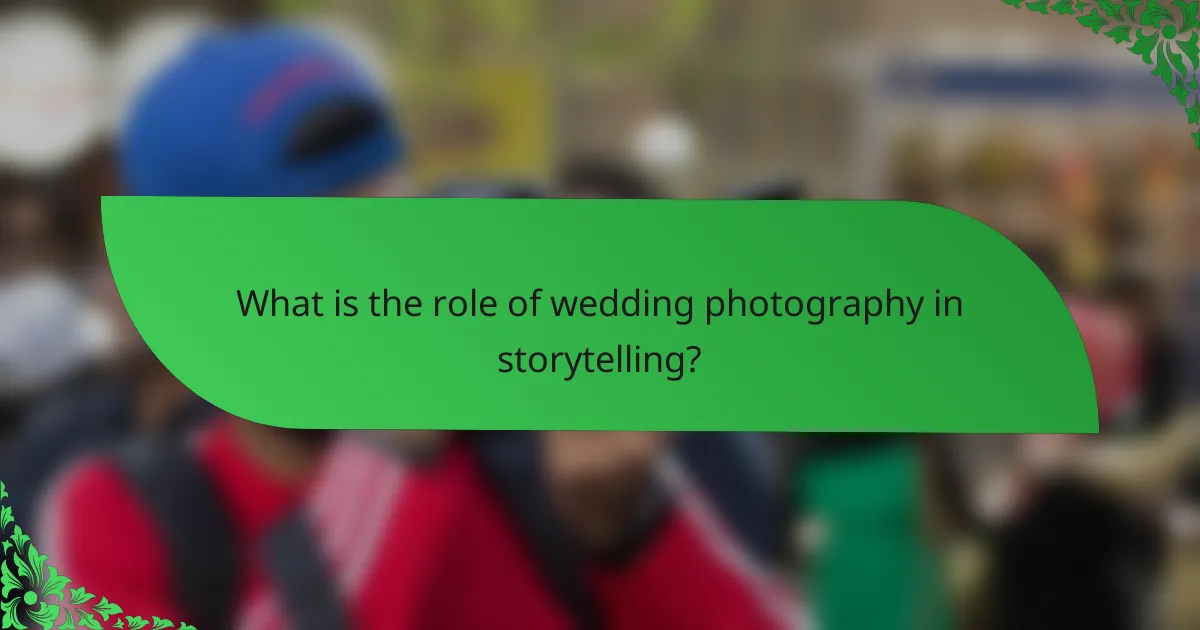
What is the role of wedding photography in storytelling?
Wedding photography serves as a visual narrative tool that captures and conveys the story of a couple’s special day. It documents key moments, emotions, and details that contribute to the overall narrative. Through candid shots, posed portraits, and detail images, photographers create a cohesive story that reflects the couple’s journey. Each photograph serves as a piece of the narrative puzzle, showcasing love, joy, and connection. This storytelling aspect enhances the emotional impact of the wedding experience. Studies show that visual storytelling can evoke strong emotional responses, making wedding photography crucial for preserving memories. The combination of images creates a lasting legacy that couples can revisit for years to come.
How does wedding photography capture the essence of a couple’s story?
Wedding photography captures the essence of a couple’s story by documenting their unique moments and emotions. It focuses on candid interactions, expressions, and details that reflect their relationship. Photographers often use storytelling techniques to sequence images in a way that narrates the couple’s journey. This includes capturing pre-ceremony preparations, the ceremony itself, and the celebration afterward.
Each photograph serves as a visual narrative, highlighting significant moments such as vows, first looks, and dances. These images evoke emotions and tell a story that resonates with the couple’s personal experiences. The use of light, composition, and angles further enhances the storytelling aspect.
Research shows that visual storytelling can significantly impact how memories are recalled and shared. According to a study published in the Journal of Visual Literacy, images can evoke stronger emotional responses than words alone. This reinforces the idea that wedding photography is not just about capturing images but telling a heartfelt story of love and commitment.
What key moments are essential to include in wedding photography?
Key moments essential to include in wedding photography are the ceremony, first kiss, and exchange of vows. Capturing the bride’s entrance and groom’s reaction is crucial. The couple’s first dance and cutting of the cake are significant moments. Family portraits and candid guest interactions add depth to the story. These moments reflect the emotional essence of the day. Documenting these key events creates a comprehensive narrative of the wedding.
How do emotions play a role in storytelling through wedding photography?
Emotions are central to storytelling in wedding photography. They capture moments that reflect love, joy, and connection. Photographers use techniques to evoke these feelings. Candid shots often reveal genuine emotions. Posed portraits can showcase the couple’s bond. The choice of lighting influences mood significantly. Soft lighting creates a romantic atmosphere, while bright lighting conveys happiness. Emotional storytelling engages viewers and helps them connect with the images. Research shows that emotional resonance enhances viewer engagement with photographs. Wedding photography that emphasizes emotions creates lasting memories for couples and their families.
Why is storytelling important in wedding photography?
Storytelling is important in wedding photography because it captures the emotional essence of the day. Wedding photography goes beyond mere documentation; it conveys the narrative of love and connection. Each photograph serves as a visual chapter in the couple’s story. This approach allows viewers to experience the joy, intimacy, and significance of the event. Studies show that storytelling in photography enhances emotional engagement. It creates lasting memories that resonate with the couple and their families. A well-told story through images can evoke nostalgia and reflect the couple’s unique journey. Ultimately, storytelling transforms wedding photography into a meaningful art form.
How does storytelling enhance the viewer’s experience of wedding photos?
Storytelling enhances the viewer’s experience of wedding photos by creating a narrative that connects emotions and memories. This narrative approach allows viewers to engage more deeply with the images. It transforms static moments into a cohesive story that reflects the couple’s journey. Each photograph becomes a chapter, illustrating key moments and emotions of the day. Research indicates that narratives can improve memory retention and emotional engagement. For instance, a study by Paul Zak found that storytelling can increase oxytocin levels, fostering emotional connections. Therefore, storytelling in wedding photography not only showcases moments but also enriches the overall viewer experience.
What impact does storytelling have on the couple’s memories?
Storytelling significantly enhances a couple’s memories by creating a narrative framework for their experiences. This narrative structure helps couples organize and recall their shared moments more vividly. Research indicates that storytelling activates multiple areas of the brain, reinforcing memory retention. For instance, a study published in the journal “Cognitive Science” found that stories improve memory recall by up to 20%. Couples who engage in storytelling can also deepen their emotional connection, as shared narratives foster intimacy and understanding. Additionally, storytelling allows couples to revisit and reinterpret their experiences, adding layers of meaning over time. This process can lead to a richer, more nuanced understanding of their relationship.
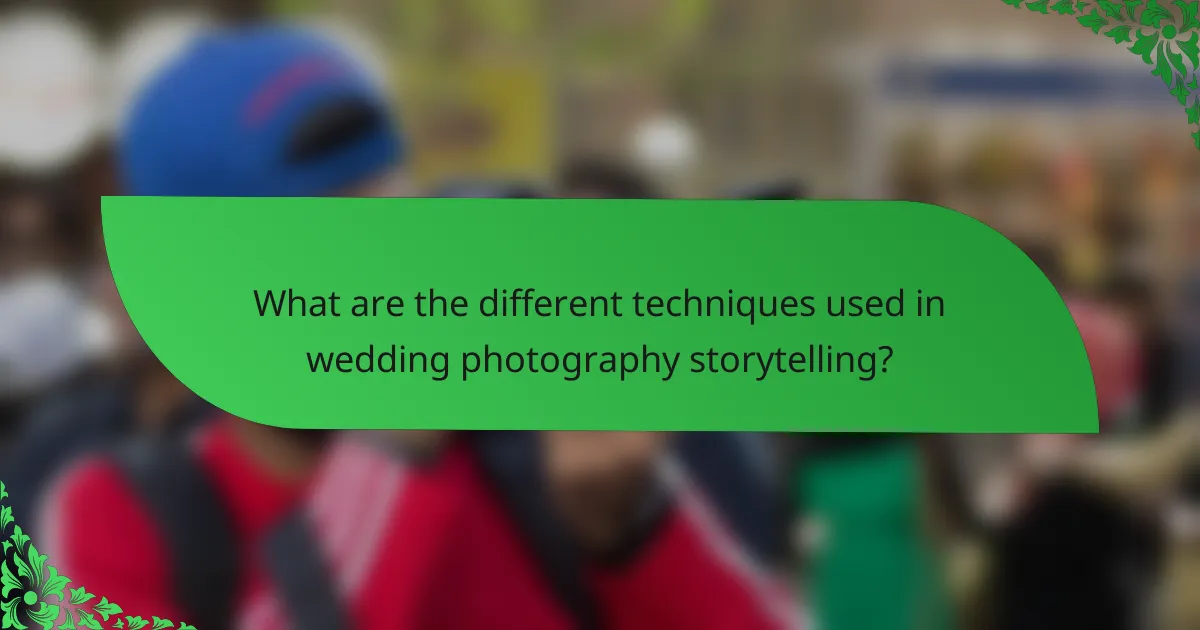
What are the different techniques used in wedding photography storytelling?
Different techniques used in wedding photography storytelling include candid photography, posed portraits, and detail shots. Candid photography captures spontaneous moments, showcasing genuine emotions. This technique often leads to authentic storytelling by reflecting the day’s natural flow. Posed portraits involve directing subjects for more structured images. These portraits often highlight relationships and key moments between individuals. Detail shots focus on elements like rings, bouquets, and decor. They add depth to the narrative by emphasizing significant aspects of the wedding. Additionally, using a mix of wide-angle and close-up shots enhances the storytelling by providing context and intimacy. Each technique contributes uniquely to the overall narrative.
How do photographers use composition to tell a story?
Photographers use composition to tell a story by arranging visual elements in a way that conveys emotions and narratives. They employ techniques such as the rule of thirds, leading lines, and framing to guide the viewer’s eye. These compositional strategies create focal points that highlight key moments or subjects. For example, placing the couple off-center can evoke a sense of intimacy. Additionally, depth of field can isolate subjects from the background, emphasizing their significance. Photographers also use light and shadow to create mood and enhance storytelling. By capturing candid moments and interactions, they reveal the relationships and emotions present in a scene. Overall, effective composition transforms a simple image into a compelling narrative.
What are the principles of effective composition in wedding photography?
Effective composition in wedding photography involves several key principles. These principles include the rule of thirds, leading lines, and framing.
The rule of thirds suggests dividing the frame into a grid of nine equal sections. Placing subjects along these lines or intersections creates balance and interest. Leading lines guide the viewer’s eye towards the subject, enhancing depth and perspective. Framing involves using elements in the scene to create a ‘frame’ around the subject, drawing attention to it.
Additionally, symmetry can create a sense of harmony in compositions. Negative space helps to isolate the subject, making it stand out. Variety in angles and perspectives adds dynamism to the images.
These principles are supported by the fact that well-composed photographs engage viewers more effectively. Research shows that viewers are more likely to connect emotionally with images that adhere to these compositional techniques.
How does lighting influence storytelling in wedding photography?
Lighting significantly influences storytelling in wedding photography. It sets the mood and tone of each image. Different lighting conditions evoke various emotions. For example, soft, natural light creates a romantic atmosphere. Harsh lighting can convey intensity or drama. Photographers often use golden hour lighting for its warm, flattering qualities. This enhances the emotional impact of the couple’s moments. Additionally, creative use of shadows can add depth to the narrative. Studies show that lighting affects viewer perception and engagement. Properly utilized, lighting becomes a powerful storytelling tool in wedding photography.
What role does candid photography play in storytelling?
Candid photography plays a crucial role in storytelling by capturing authentic moments. It reveals genuine emotions and interactions among subjects. This form of photography allows viewers to connect with the narrative on a personal level. Candid shots often convey spontaneity and rawness, enhancing the overall story being told. Unlike posed images, candid photos reflect real-life experiences. They create a sense of intimacy and engagement for the audience. Studies show that images depicting real emotions resonate more with viewers. Candid photography enriches the storytelling aspect of wedding photography by illustrating the event’s true essence.
How can candid shots enhance the narrative of the wedding day?
Candid shots enhance the narrative of the wedding day by capturing genuine emotions and spontaneous moments. These images reflect the true atmosphere and interactions among guests. They tell a story that posed photographs often miss. Candid photography allows for a more authentic representation of the day’s events. This style can reveal connections between family and friends. Research indicates that authentic moments resonate more with viewers. According to a study by the University of Southern California, genuine expressions evoke stronger emotional responses. Therefore, candid shots contribute significantly to the overall storytelling of the wedding day.
What techniques can photographers use to capture candid moments effectively?
Photographers can use various techniques to effectively capture candid moments. One technique is to remain unobtrusive, allowing subjects to act naturally. This can be achieved by using longer lenses, which permits distance while still capturing intimate details. Another method involves anticipating moments by observing interactions and emotions. Photographers should be aware of the environment and the dynamics between people.
Utilizing continuous shooting mode can help capture fleeting expressions. This mode allows for multiple frames to be taken in quick succession. Additionally, shooting in natural light can create a more authentic atmosphere, enhancing the candid feel.
Finally, building rapport with subjects can lead to more genuine moments. When subjects feel comfortable, they are more likely to express themselves freely. These techniques collectively contribute to the effective capture of candid moments in photography.
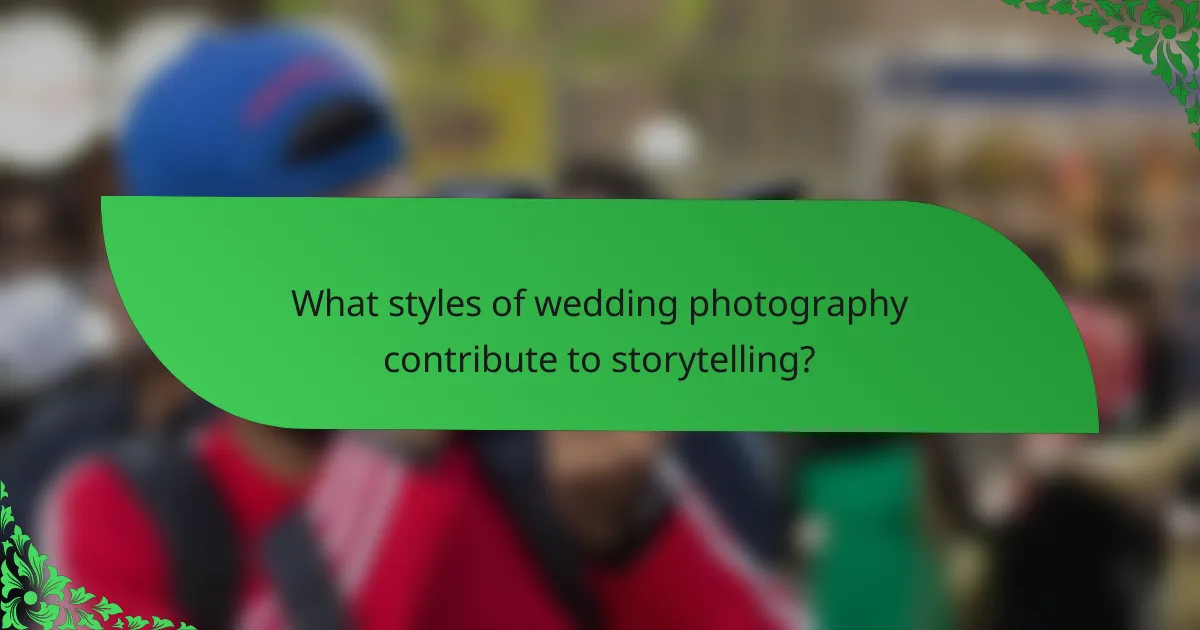
What styles of wedding photography contribute to storytelling?
Documentary wedding photography contributes significantly to storytelling. This style captures candid moments and emotions throughout the wedding day. It focuses on real interactions and spontaneous events. The aim is to document the day as it unfolds. This creates a narrative that reflects the couple’s unique experience.
Another style is fine art wedding photography. This approach combines artistic vision with storytelling elements. It often incorporates creative compositions and unique perspectives. Fine art photography aims to evoke emotions and convey the couple’s story through visual artistry.
Traditional wedding photography also plays a role in storytelling. This style includes posed portraits and formal group shots. While it may seem less spontaneous, it captures important family dynamics. These images help narrate the couple’s background and relationships.
Lastly, editorial wedding photography contributes to storytelling through styled shoots. This style focuses on aesthetics and themes. It tells a story through carefully curated visuals. The goal is to create a cohesive narrative that highlights the couple’s style and vision.
Each of these styles provides a different perspective on the wedding day. Together, they create a comprehensive narrative that celebrates the couple’s journey.
How do traditional styles differ from documentary styles in storytelling?
Traditional styles focus on posed, staged moments, while documentary styles capture candid, unposed events. Traditional storytelling often emphasizes idealized representations of subjects, creating a narrative that is more controlled. This method typically involves directing subjects to achieve specific compositions. In contrast, documentary storytelling aims to present a more authentic view of events as they unfold naturally.
Traditional styles may include formal portraits and structured sequences. These can enhance the aesthetic appeal but may lack spontaneity. Documentary styles prioritize real emotions and interactions, showcasing genuine moments. This approach often results in a narrative that reflects the true essence of the event.
Evidence of these differences can be seen in wedding photography. Traditional photographers may create a series of posed images, while documentary photographers capture the day as it happens. Studies show that couples often prefer the authenticity of documentary styles for their emotional resonance.
What are the defining characteristics of traditional wedding photography?
Traditional wedding photography is characterized by posed portraits, formal compositions, and a focus on key moments. This style emphasizes capturing the couple, family, and guests in a structured manner. It often includes classic shots like the first kiss and cake cutting. The use of natural lighting is common, enhancing the emotional tone of the images. Photographers typically work with a shot list to ensure all important moments are documented. Traditional wedding photography aims to create timeless images that tell the story of the day. This approach has been a staple since the inception of wedding photography in the mid-19th century. Historical context shows that this style has evolved but remains rooted in capturing significant events and emotions.
How does documentary wedding photography create a narrative flow?
Documentary wedding photography creates a narrative flow by capturing real moments as they unfold. This style emphasizes candid shots over posed images. The photographer tells a story through sequences of images that depict events and emotions. Each photograph contributes to the overall storyline of the day. The approach allows for authentic expressions and interactions to be documented. This results in a cohesive visual narrative that reflects the couple’s unique experience. By focusing on genuine moments, the narrative flow becomes relatable and engaging for viewers. The use of natural light and composition further enhances the storytelling aspect.
What emerging styles are influencing storytelling in wedding photography?
Candid photography and documentary styles are emerging as influential trends in wedding photography storytelling. These styles focus on capturing genuine emotions and spontaneous moments. Candid photography emphasizes natural interactions, often resulting in more authentic narratives. Documentary styles narrate the event as it unfolds, showcasing the day’s progression without staged setups. Additionally, fine art photography is gaining traction, blending artistic composition with storytelling elements. This style often incorporates creative framing and unique perspectives. Each of these styles contributes to a more personalized and immersive storytelling experience in wedding photography.
How does fine art photography approach storytelling differently?
Fine art photography approaches storytelling through a focus on artistic expression and emotional depth. It prioritizes aesthetics and conceptual themes over traditional narrative structures. This form of photography often uses symbolism and abstraction to evoke feelings rather than convey a linear story. Fine art photographers may manipulate light, composition, and color to create mood and atmosphere. Unlike documentary styles, fine art photography invites interpretation and personal connection from the viewer. This approach allows for diverse narratives, as each viewer may derive different meanings from the same image. The emphasis on personal vision and creativity distinguishes fine art photography in the storytelling landscape.
What is the impact of digital editing on storytelling in wedding photography?
Digital editing significantly enhances storytelling in wedding photography. It allows photographers to manipulate images for emotional impact. Adjustments in color grading can evoke specific moods. Cropping can focus attention on key moments. Retouching can enhance the subjects’ features, making them more appealing. Layering techniques can create artistic compositions that tell a deeper story. The use of filters can unify the visual narrative. Overall, digital editing transforms raw images into compelling narratives that resonate with viewers.
What are some best practices for capturing emotional impact in wedding photography?
To capture emotional impact in wedding photography, focus on candid moments and genuine expressions. Utilize natural light to enhance the mood of the images. Position yourself strategically to anticipate emotional moments, such as vows or first looks. Encourage couples to interact naturally to evoke authentic emotions. Pay attention to details, like hands holding or tears of joy, to tell a deeper story. Use a variety of angles to convey different perspectives on emotional moments. Post-processing can enhance the emotional tone of images, but maintain authenticity. Consistently review successful wedding photographers’ portfolios to learn effective techniques.
How can photographers prepare to capture genuine emotions during the event?
Photographers can prepare to capture genuine emotions during an event by building rapport with subjects beforehand. Establishing a connection helps subjects feel comfortable and authentic. Photographers should also scout the venue in advance. Knowing the layout allows for strategic positioning to capture candid moments.
Using a documentary style encourages natural interactions, leading to genuine emotional expressions. Photographers can create a relaxed atmosphere by engaging in light conversation. This approach helps subjects to be themselves.
Additionally, being observant and anticipating moments is crucial. Photographers should focus on key interactions that evoke emotions, such as laughter or tears.
Finally, utilizing continuous shooting mode can help capture fleeting expressions. This technique increases the chances of documenting those genuine emotional moments.
What techniques can enhance the emotional resonance of wedding photographs?
Techniques that can enhance the emotional resonance of wedding photographs include candid photography, storytelling through images, and utilizing natural light. Candid photography captures genuine emotions and moments, creating a more authentic narrative. Storytelling through images involves capturing key moments and details that reflect the couple’s journey. Utilizing natural light adds warmth and softness to photographs, enhancing the overall mood. Additionally, incorporating personal elements, such as heirlooms or meaningful locations, deepens emotional connections. Research indicates that emotional resonance in photography can significantly impact viewer engagement and memory retention.
The main entity of this article is wedding photography, which serves as a visual storytelling tool that captures the essence of a couple’s special day through key moments, emotions, and details. The article explores various techniques and styles, including candid, documentary, and fine art photography, emphasizing their roles in creating a cohesive narrative. It also discusses the importance of emotions in enhancing storytelling, the impact of digital editing, and best practices for capturing genuine moments. Overall, the content highlights how effective wedding photography not only documents events but also preserves lasting memories for couples and their families through compelling narratives.
